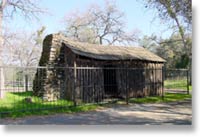 |
The cabin of Mark Twain and Bret Harte,
where Twain wrote "The
Celebrated Jumping Frog of Calaveras County"
The cabin is located on Jackass Hill just outside of Sonora,
near Columbia. |
It
was in 1806 that explorer Gabriel Moraga's expedition first entered
the foothills home to the Mi-Wuks and discovered the Stanislaus
River. In 1841 The Bidwell - Bartelson party summits the Sierra
to enter the area now known as Tuolumne County. Included in the
party are Nancy Kelsy and her baby the first white American females
to cross the rugged pass.
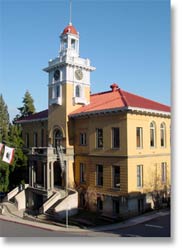 It
is likely that if James Marshall had not discovered gold in the
tail race of Sutter's Mill someone else would have, within days,
claimed the tittle of "The first to discover Gold in California."
Up and down the entire length of what is now Hwy 49 it seems someone
was picking up or stumbling over a nugget of gold, where in a
new town would spring up overnight. Sonora's story is no different
and was quick to join the ranks of Gold Discovery sites in California
soon after Marshall's find. It
is likely that if James Marshall had not discovered gold in the
tail race of Sutter's Mill someone else would have, within days,
claimed the tittle of "The first to discover Gold in California."
Up and down the entire length of what is now Hwy 49 it seems someone
was picking up or stumbling over a nugget of gold, where in a
new town would spring up overnight. Sonora's story is no different
and was quick to join the ranks of Gold Discovery sites in California
soon after Marshall's find.
In May of 1848 a group of Native Americans
working for Charles M. Weber discovered gold along the Stanislaus
River. Then in July of 1848, Benjamin Wood, James Savage and company
discovered gold in Wood's Creek near Jamestown. Within two years
the population of Tuolumne County had grown to nearly 20,000 people;
miners searching for gold and merchants looking for a way to profit
from those seeking gold.
The Mi-Wuk Indians were first
to call the lush, rolling oak covered foothills
near the Stanislaus River their home. Their once
tranquil surroundings, were quickly transformed
into a gold rush town by miners, pioneers, loggers
and later with the introduction of the railroad. On
February 18, 1850 the California legislature
established Tuolumne County, and on May 1, 1851
incorporated the city of Sonora.
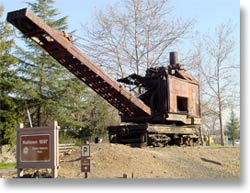 Before
and after the Civil War, the area suffered a depression, with
a mass departure of the counties population. However, a second
Gold Rush started on or around January of 1870 marked by the incorporation
of the Guild Mining Company. This resurgence of mining was due
to the impressive successes of the hard rock and hydraulic mining
operations Before
and after the Civil War, the area suffered a depression, with
a mass departure of the counties population. However, a second
Gold Rush started on or around January of 1870 marked by the incorporation
of the Guild Mining Company. This resurgence of mining was due
to the impressive successes of the hard rock and hydraulic mining
operations
Through the late 1800's until 1925 when the
Melones dam and powerhouse were built, the area transformed from
the rough and ready mining town it was in the mid 1800's to a
significant California city who's prospering industries included
lumber, farming, and the railroad. Sonora had electric power by
1892 and paved roads by 1922.
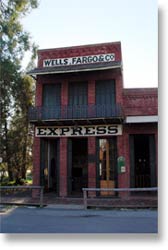 To
those of you traveling to this area for the first time, truly
the best way to learn and enjoy the rich history of Tuolumne County
is to visit the two state historic parks and museums located just
outside Sonora. The Columbia State Historic Park, known as the
best preserved Gold Rush town in California, and Railtown 1897
State Historic Park. To
those of you traveling to this area for the first time, truly
the best way to learn and enjoy the rich history of Tuolumne County
is to visit the two state historic parks and museums located just
outside Sonora. The Columbia State Historic Park, known as the
best preserved Gold Rush town in California, and Railtown 1897
State Historic Park.
|

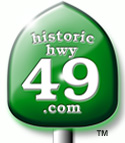

 It
is likely that if James Marshall had not discovered gold in the
tail race of Sutter's Mill someone else would have, within days,
claimed the tittle of "The first to discover Gold in California."
Up and down the entire length of what is now Hwy 49 it seems someone
was picking up or stumbling over a nugget of gold, where in a
new town would spring up overnight. Sonora's story is no different
and was quick to join the ranks of Gold Discovery sites in California
soon after Marshall's find.
It
is likely that if James Marshall had not discovered gold in the
tail race of Sutter's Mill someone else would have, within days,
claimed the tittle of "The first to discover Gold in California."
Up and down the entire length of what is now Hwy 49 it seems someone
was picking up or stumbling over a nugget of gold, where in a
new town would spring up overnight. Sonora's story is no different
and was quick to join the ranks of Gold Discovery sites in California
soon after Marshall's find. Before
and after the Civil War, the area suffered a depression, with
a mass departure of the counties population. However, a second
Gold Rush started on or around January of 1870 marked by the incorporation
of the Guild Mining Company. This resurgence of mining was due
to the impressive successes of the hard rock and hydraulic mining
operations
Before
and after the Civil War, the area suffered a depression, with
a mass departure of the counties population. However, a second
Gold Rush started on or around January of 1870 marked by the incorporation
of the Guild Mining Company. This resurgence of mining was due
to the impressive successes of the hard rock and hydraulic mining
operations  To
those of you traveling to this area for the first time, truly
the best way to learn and enjoy the rich history of Tuolumne County
is to visit the two state historic parks and museums located just
outside Sonora. The Columbia State Historic Park, known as the
best preserved Gold Rush town in California, and Railtown 1897
State Historic Park.
To
those of you traveling to this area for the first time, truly
the best way to learn and enjoy the rich history of Tuolumne County
is to visit the two state historic parks and museums located just
outside Sonora. The Columbia State Historic Park, known as the
best preserved Gold Rush town in California, and Railtown 1897
State Historic Park.